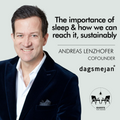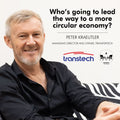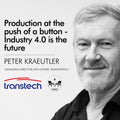Industry, Consumer or Government - Who Makes The Real Difference in Fashion?
Industry, consumer or government - who makes the real difference in fashion?
PART 2 OF GUESTS FOR CHANGE with KARLA MAGRUDER
Within the Guests for Change series, thought leaders, pioneers, visionaries, and game-changers are interviewed to give us more insight into the world of sustainability and circularity. Continuing from part one, in an exclusive conversation with Karla Magruder, we gain an insight into the important roles needed in the textile industry, how as a consumer you can tell the difference between realistic transparency and greenwashing, and where she thinks the real power behind change is...
When it comes to creating changes in the fashion and textile industries, Karla has an invaluably vast depth of experience to draw on. She highlights the importance of educating yourself, as a consumer, on the subject of circularity - and true to her curious nature - she advocates taking an investigative stance. Try to understand the bigger picture of brands that you like and support. When you know where they are coming from, and where they envision heading towards, you can make a far more educated choice. Keep an eye out too for consumer-facing certifications, as these can be a good indication of making the distinction between what is real and what is greenwashed.
Image by Jordan Nix from Unsplash
Teaching consumers how to reuse, what to do with their used garments, not to overbuy, and to be careful where they are buying from are all important factors in the process of initiating change. As an example of progress, Karla highlighted how Fashion Revolution Luxembourg is making good headway in communicating what consumers can do to become active players in the industry. (Watch our discussion with Stylianee Parascha on Fashion Revolution Luxembourg here.)
But, considering how hard it is for consumers to fully understand the reality of the impacts of their purchases, it is also clear from Karla’s perspective that the industry itself needs to step up as the primary driver of change.
“I think that the power, the real power behind change, is with the industry” she shares.
In Karla’s eyes, it is players within the fashion industry who decide what to make, how to make it, where to make it, and how much things costs. Brands and retailers hold far more power over these choices than we initially may think. These are the players that actively choose how to make products in more responsible ways, and how fair those who are making them are treated.
Image by Fran Hogan from Unsplash
To make this point more tangible, Karla described the process of an item in production.
While in the past, the textile and fashion industries involved shorter supply chains and a more intimate relationship between growers, producers and consumers - things have inevitably changed. And Karla has seen most of it happen. Heralding the arrival of a more digitalized era, and the Fourth Industrial Revolution (Industry 4.0) being upon us, there are spaces that are opening up within the industry that were never there before. Karla recognizes a real need for engineers and those skilled in IT to streamline the development of the more technical aspects. There is also a real need for those with the skills to drive ways of measuring carbon reduction. She also identified the need for chemists within the fashion industry. Knowing what is in the materials being used, the correct finishing of chemicals, and what is actually applied to textiles all become invaluable routes to drive change in the industry.
Image by Tijana Drndarski from Unsplash
Initially, as an example, cotton is grown. It is then picked, sorted, spun into thread, knitted or woven into a fabric, and then made into a product. From there, it is likely that it is shipped across the world to a distribution center. Only at this point, does it make its way into a store. Taking all of this into consideration, logically one would expect that the costs of all the steps involved would add up to a sum greater than the $5 or handful of Euros that it is sold at. Within this process, Karla states, someone is clearly not getting paid fairly. And this is something that needs to change. The impacts that a more fair or equitable approach can have are vast. Everyone from the cotton pickers to the store owners could indeed benefit, while even the environment in which the cotton plants are grown could potentially be improved with fairer costing.
It’s no longer just a space for fashionistas - the time has come for scientists and even computer programmers to make strides into the world of fashion!
In addition to the consumer and producer levels, on a governmental level, Karla is an advocate for improved policies to be in place. Things like textile take-back programs and theExtended Producer Responsibility (EPR) policyare opportunities for the government to make changes. And it is up to us, as conscious consumers, to support these programs and to take an active role in advocating for such policies from our government.
Image by Roberto Reposo from Unsplash
To circle it back to what you as a consumer can do, Karla highlights that if you really care about the environment, you simply can’t continue to buy and wear tons of new clothing. Thinking that if it’s “circular” you are all set doesn’t work yet. The entire system needs to form a closed loop for circularity to be effective. Karla believes that we have to acknowledge, “Hey, there’s a limit to how much clothing we need!” - and it is in this notion that one can become a more conscious consumer working for change.
Watch the full conversation with Karla Magruder by clicking on the video below, and keep an eye out for our next Guest in the Guests for Change series.








Leave a comment